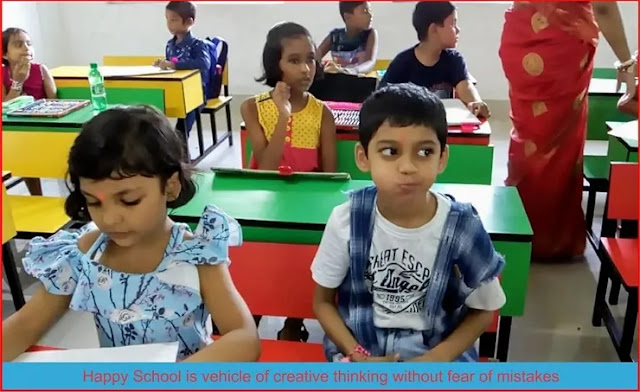Happy School is vehicle of creative thinking without fear of mistakes
The Concept of a Happy School Although new to the world, India as its tradition embraced the idea of happy and well-engaged schooling through its Gurukulam seva.
In 2014 UNESCO propounded the basic framework of Happy School. In this article, we discuss about happy school model.
Basic emphasis on this concept is given to the well-being of young learners. From this point, we start the story. For identifying a happy school scenario UNESCO has divided the framework into three broad categories. The first one is People, the second is process and the third is place.
Under the First category of people Interpersonal happy and relaxing relation within the educational community has been given paramount importance for a happy school. In this area, they break down into several sub-points. Friendships and relationships in the school community are considered important practices of a happy school. Another important criterion for happy schools in this area is positive teacher attitudes and attributes, which reverberate kindness, enthusiasm, and fairness, and the role of teachers in serving as inspiring, creative, and happy role models for young minds. Another criterion that is included is mutual respect and acceptance.
The flow of respect and acceptance goes from top to bottom without excluding anyone. This is important to bring together all as a single unit to promote efficiency on a happy note.
Under the second category of process learning and teaching, methodologies are taken as tools to promote the well-being of learners at Happy School. Under this category issues like the overload of homework, no play, and continuous pressure for exams are addressed in identifying reasonable and fair workload for students to sustain the balance between study and play and moreover between memorization and creative minds.
The second most important point that is raised under this category is to identify the hurdles or blockages for thinking creatively without fear of mistakes. It is like freedom for learners to express his or her views without fear of being on the wrong side. In one line "Learning without worrying".
"What do you think about a student who gets ten out of ten on a civic education exam about honesty, but has actually cheated in the exam to get such high marks? Or we learn biology to protect our environment – some students get really good marks in biology exams, but they litter trash in the street! We must emphasize that the main purpose of studying is to improve our real life and to help our countries develop. We are not learning to be geniuses or to make our brains bigger! We always say ‘knowledge is power', but according to the American author Dale Carnegie, ‘Knowledge isn’t power until it is applied’." as envisioned in this study. Under this criterion contents and curriculum provided to learners must be relevant and contemporary. All redundant and superfluous information added for name sake should ideally be replaced with new, updated, and well-researched topics where the learner finds an opportunity to use it in his or her daily life.
Under the third category of place, one needs to identify both the physical environment and school atmosphere to measure the level of happiness in any school. Among the criteria relaxing and friendly learning environment is placed among the most important factors of a happy school. “Sansakara” or well manners and etiquette are considered the primary source of spreading happiness in a place where greetings and smiles are the order of the day. Music and arts and the display of a colorful and meaningful approach toward learners are primary seeds of growing positivity in the school environment.
A secure environment where shared study, play, and engagements are encouraged for learners is truly blessed with happy energy. The role of management and leadership in bringing more positivity can’t be undermined and proactive leadership can only guarantee such a happy and congenial atmosphere for all learners.
In terms of the physical environment, the need for open and green space for creative learning to enhance learner’s happiness and well-being is also given importance. Outdoor space which is full of green where learners can get engaged with nature is also of paramount importance for a happy school.
Whereas education and learning are recognized as a fundamental vehicle to enhance happiness and well-being of learners steps must be taken to bring metamorphic change in the education system to include creative forms of learning that allow for learners’ unique talents and strengths to shine, while at the same time recognizing that happiness is something collective that can be spread through learning experiences and foster friendships and healthy relationships among the stakeholders of the school community.


.png)
Comments
Post a Comment